PtCu nanoalloy loaded on sulfur-doped porous g-C3N4 for electrocatalytic hydrogen evolution†
Abstract
Graphitic carbon nitride (g-C3N4), as a carbon support material with excellent stability and abundant active sites, has found widespread applications in various fields, including photocatalytic water splitting, electrolysis of water, and CO2 reduction. Presently, research on the modification of g-C3N4 primarily focuses on atomic doping, defect engineering, and the decoration of metal nanoparticles. In this study, a method involving the high-temperature pyrolysis of a solution containing thiourea and urea was successfully employed to synthesize sulfur-doped porous g-C3N4 (S-C3N4) nanosheets. Subsequently, PtCu nanoparticles were loaded onto the S-C3N4 through a hydrothermal process. In the case of Pt loading of less than half of 20% Pt/C, this catalyst exhibited a low overpotential of only 10 mV at a current density of 10 mA cm−2, which is significantly better than the 35 mV overpotential of 20% Pt/C. Furthermore, after a long period of continuous current stability testing, the overpotential of the catalyst did not increase by more than 30 mV, demonstrating excellent stability. The porous S-C3N4 nanosheets possess a large specific surface area, providing abundant active sites for the HER reaction. This research introduces a fresh method for creating innovative catalysts based on Pt alloys supported by a carbon carrier.



 Please wait while we load your content...
Please wait while we load your content...